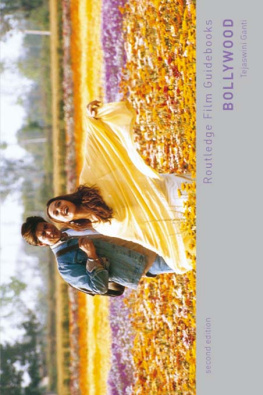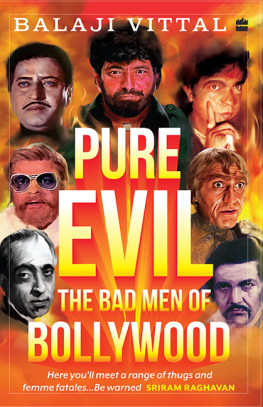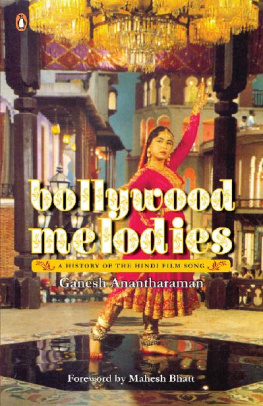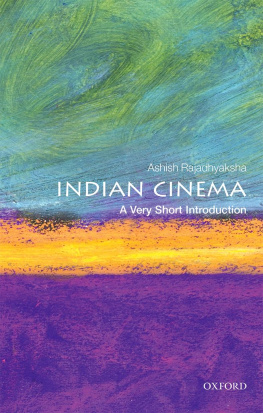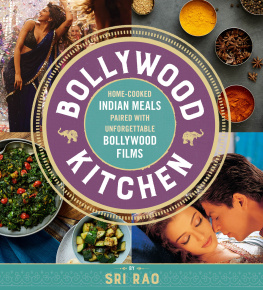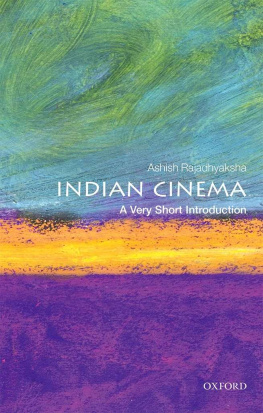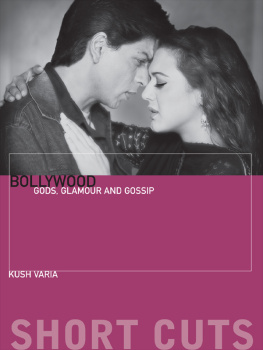BOLLYWOOD
This new and fully updated edition of Bollywood provides readers with a guide to the cultural, social and political significance of Hindi cinema, outlining the history and structure of the Bombay film industry, and the development of popular Hindi filmmaking since the 1930s.
Tejaswini Ganti also provides information and commentary on the key players in Bollywood, including directors and stars, as well as material from current filmmakers. Features of this new edition include:
an updated history of Bollywood with a new discussion of films released in the last decade;
two new chapters: Genre and Hindi cinema and Narrative style, important themes and key conflicts;
new interviews with directors and screenwriters about the impact of multiplexes, corporatization, and Hollywood partnerships on Hindi filmmaking;
more images to help bring films alive, updated resources with more suggestions for reading, and discussions of newer films and more recent directors.
Information on the production and distribution of Hindi cinema has also been updated and revamped to incorporate the changes in the political economy of filmmaking. Overall, this new edition provides a concise but comprehensive guide to one of the worlds leading film industries.
Tejaswini Ganti is an Associate Professor of Anthropology in the Program in Culture and Media at New York University.
Routledge Film Guidebooks
The Routledge Film Guidebooks offer a clear introduction to and overview of the work of key filmmakers, movements or genres. Each guidebook contains an introduction, including a brief history; defining characteristics and major films; a chronology; key debates surrounding the filmmaker, movement or genre; and pivotal scenes, focusing on narrative structure, camera work and production quality.
Bollywood: A Guidebook to Popular Hindi Cinema, 2nd Edition Tejaswini Ganti
Crime Sarah Casey Benyahia
Documentary Dave Saunders
Film Noir Justus Nieland and Jennifer Fay
Horror Brigid Cherry
James Cameron Alexandra Keller
Jane Campion Deb Verhoeven
Romantic Comedy Claire Mortimer
Science Fiction Mark Bould
Westerns John White
BOLLYWOOD
A Guidebook to Popular Hindi Cinema
Second edition
TEJASWINI GANTI

Second edition published 2013
by Routledge
2 Park Square, Milton Park, Abingdon, Oxon OX14 4RN
Simultaneously published in the USA and Canada
by Routledge
711 Third Avenue, New York, NY 10017
Routledge is an imprint of the Taylor & Francis Group, an informa business
2013 Tejaswini Ganti
The right of Tejaswini Ganti to be identified as author of this work has been asserted by her in accordance with sections 77 and 78 of the Copyright, Designs and Patents Act 1988.
All rights reserved. No part of this book may be reprinted or reproduced or utilized in any form or by any electronic, mechanical, or other means, now known or hereafter invented, including photocopying and recording, or in any information storage or retrieval system, without permission in writing from the publishers.
Trademark notice: Product or corporate names may be trademarks or registered trademarks, and are used only for identification and explanation without intent to infringe.
First published 2004 by Routledge
British Library Cataloguing in Publication Data
A catalogue record for this book is available from the British Library
Library of Congress Cataloging in Publication Data
Ganti, Tejaswini.
Bollywood : a guidebook to popular Hindi cinema / by
Tejaswini Ganti. -- 2nd ed.
p. cm. -- (Routledge film guidebooks)
Includes bibliographical references and index.
1. Motion picture industry--India--Bombay. 2. Motion pictures,
Hindi--India--Bombay. I. Title.
PN1993.5.I8G265 2013
791.430954--dc23
2012032391
ISBN: 978-0-415-58384-8 (hbk)
ISBN: 978-0-415-58388-6 (pbk)
ISBN: 978-0-203-83441-1 (ebk)
Typeset in Joanna
by Taylor & Francis Books
CONTENTS
LIST OF FIGURES
PREFACE TO SECOND EDITION
A lot has changed in the world of Hindi filmmaking since the first edition of Bollywood: A Guidebook to Popular Hindi Cinema was published eight years ago, but at the same time many things have stayed the same. This edition reflects both processes: it keeps much of the material that readers over the years have indicated they found useful, but it also includes new elements as well. I have updated the Introduction and as form their own evaluations, based on personal tastes and preferences.
The biggest change I have incorporated into this edition is two new chapters: on genre. Given how frequently the book has been used in undergraduate teaching, I thought an accessible discussion about narrative style and genre would be useful, and provide readers with the tools to understand and appreciate Hindi cinema on its own terms of reference. I hope teachers, students, and the interested general reader agree. The last development to mention is that the academic study of popular Hindi cinema has grown exponentially since the last edition, and therefore readers will find a much more augmented list of suggestions for further reading, which will continue to guide them further into the rich and fascinating world of Hindi cinema.
Tejaswini Ganti
New York City, August 2012
ACKNOWLEDGEMENTS
I am especially grateful to the following individuals: Javed Akhtar, Shabana Azmi, Shyam Benegal, Ritha Bhaduri, Pooja Bhatt, Vikram Bhatt, the late Sachin Bhaumick, Aditya Chopra, Madhuri Dixit, Subhash Ghai, Sutanu Gupta, Ravi Gupta, Rumi Jaffrey, Ayesha Jhulka, the late Shammi Kapoor, Shashi Kapoor, Aamir Khan, Shah Rukh Khan, Punkej Kharabanda, Govind Nihalani, Anjum Rajabali, Rakesh Roshan, Sharmishta Roy, Shravan Shroff, and Ramesh Sippy for the interviews and communications which I have excerpted in the book. I thank Shyam Shroff for all of the insights he has provided me over the years about film distribution. Aliya Curmally and Priyadarshini Shankar helped with the painstaking task of interview transcriptions. A big thanks to Ishita Srivastava and Omkar Goswami for helping to calculate the Purchase Power Parity rate between the U.S. dollar and Indian rupee. Finally, my heartfelt appreciation to Vipul Agrawal for his patience, good humor, and helpful feedback.

Map, Contemporary South Asia. Image courtesy of the author.

INTRODUCTION
Okay, five-six-seven-eight! a woman shouted into a microphone and blew a whistle to signal to the sound-engineer on the other side of the room. As soon as the music began, a man in a white chefs uniform started dancing and juggling vegetables, while long-legged waitresses in black T-shirts, miniskirts, and white aprons passed behind him. Once the song started, the man began to mouth the words so perfectly that he appeared to be singing it himself. Men crouching toward the ground slowly pushed a trolley with the cameraman and movie camera toward the performer. With a sound of the whistle, and a Cut it! the music stopped, as did the action. The woman went over to the man in the chefs outfit and demonstrated a few dance steps. After watching her, the man mimicked her exact movements. Okay, one more rehearsal, and then well do a take. The woman blew the whistle and the whole sequence started all over again.
Next page
